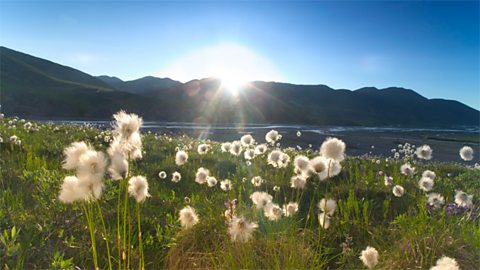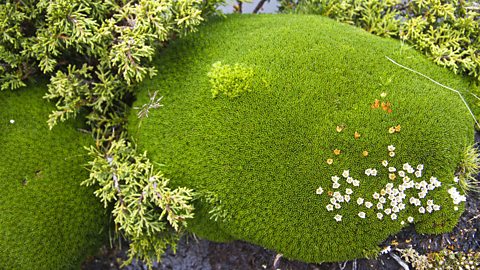Tundra ecosystem
Conditions and vegetation adaption
Tundra environments are known as 'the land without trees'. The very cold and dry climatic conditionsThe usual type of weather that occurs in an area. mean that these areas contain only a small variety of plants and animals, in comparison to the rainforestA natural region located between the Tropics..
The soil is permanently frozen for much of the year and is known as permafrostPermanently frozen soil.. Even at the peak of summer, the soil underneath the surface remains frozen. As a result, plants that require deep root systems cannot survive - vegetation is low and fast growing.
The growing seasonThe length of time it takes for plants to fully mature. is only about 50 to 60 days long and the thin soils are relatively infertileWhen there are no longer any nutrients in the soil.. The bare, rocky ground can only support low growing plants like shrubsSmall bush-like plants., mossesSmall plants that grow in damp or shaded places., heathRough grassland., and lichenA type of fungus that grows on rock.. The combination of permafrost, short summers and seasonal waterloggingWater that submerges land and makes it marshy., accounts for the fact that trees cannot grow in the tundra.
Vegetation adaptation
Cotton grass

Vegetation needs to be able to tolerate cold and dry conditions. cotton grassA type of vegetation found in the Tundra. is a plant able to survive the harsh conditions in the tundra. The features which enable it to survive are:
- It is short, which protects it from the wind, and snow cover in winter shields it from the extreme cold.
- It scatters seeds in the wind.
- Its narrow leaves help to reduce moisture loss.
- It has a short growing season.
- Its compact flower heads reduce heat loss.
- Its darker leaves help to absorb energy from Sun.
A range of different plants have adapted to survive the tundra climate.

Image caption, Cushion plants
Cushion plants are compact and low growing to help survival. They trap airborne dust as a source of nutrients.
Image caption, Cotton grass
Cotton grass has small seeds that can easily be dispersed. It is low lying to protect it from cold wind. Thin leaves reduce water loss by transpiration. It grows and produces seeds quickly as soon as the temperature increases.
Image caption, Lichen
Lichens do not need soil to grow. They grows very slowly, can withstand very cold temperatures and survive beneath snow.
Image caption, Arctic poppy
Arctic poppies have a hairy stem to retain heat. They track the sun in the sky to maximise the amount of sunlight they receives. This can increase photosynthesis.
1 of 4